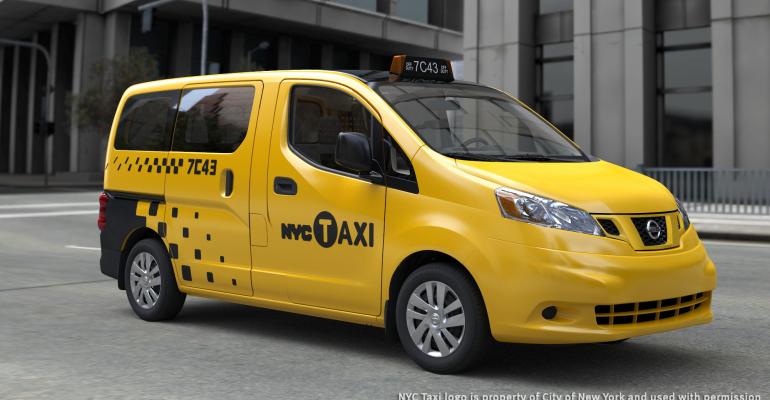CHICAGO – As a prelude to Nissan’s delivery of its first NV200 taxi cab to New York City in October 2013, the auto maker first will hand off to the city a test fleet of six Leaf electric vehicles to gauge interest in a zero-emission cab for Manhattan.
The announcement about the Leaf EVs, which the city will receive at no charge, will come next week, Joe Castelli, Nissan North America’s vice president-commercial vehicles and fleet, tells WardsAuto on the sidelines of the auto show here.
“We’d like to test the electrification of the taxi fleet,” Castelli says. “Will it work for everybody? No, just like the Leaf doesn’t work for everybody.”
For instance, a taxi driver making 12 trips a day from LaGuardia Airport east of Manhattan across to Newark Airport west of the city in New Jersey would not be able to use an EV due to a range limit of about 100 miles (160 km) on a full charge.
“This isn’t for him,” Castelli says. “But if we structure it for someone who wants to stay in lower Manhattan, this might work for an 8-hour shift.”
Getting the charging infrastructure in place to sustain growing numbers of EVs in Manhattan will determine whether an electric taxi is viable.
Nissan is offering the city three Level II chargers at no expense. The first will be located at LaGuardia. The city will decide the location of the other two.
“In the cab line at LaGuardia, the drivers have downtime,” Castelli says. “They could charge their taxis while taking a rest.”
Nissan is talking with other companies and agencies interested in helping build the EV infrastructure in New York, a city known for its green initiatives. Nissan officials met recently with managers of the Intercontinental Hotel who are interested in installing a Level II charger.
“The infrastructure is always big in any city. You have to take that (range) anxiety away,” Castelli says. “In a controlled environment, as much as Manhattan can be a controlled environment, it will be good opportunity to try it. In the right environment and with the right application, I think it can work.”
Nissan won the 10-year contract to supply New York taxis in spring 2011, a deal estimated to be worth more than $1 billion. The other two finalist bidders were Turkish manufacturer Karsan Otomotiv and Ford, whose Transit Connect is a direct competitor to the NV200, which goes on sale in the U.S. next February as a compact cargo vehicle before the cab arrives.
To be assembled in Cuernavaca, Mexico, the NV200 has a unibody structure and uses the same powertain as the compact Sentra sedan, a 2.0L naturally aspirated 4-cyl. engine and continuously variable transmission.
On sale for nearly a year is Nissan’s larger, fullsize body-on-frame NV cargo van, which shares its V-6 and V-8 powertrains with the Titan fullsize pickup.
Both the Titan and NV come from Nissan’s plant in Canton, MS. A passenger version of the fullsize NV goes on sale this spring and was unveiled at the auto show here.
Castelli says it was a coup for Nissan to win the New York taxi contract. More than 13,230 taxi cabs currently operate in the city. He says it will take three to four years for the entire taxi fleet to convert to the NV200 platform.
Most New York taxis stay in the market three years and are driven about 75,000 miles (120,698 km) annually, he says.
The city’s Taxi and Limousine Commission has authorized adding 2,000 more taxis to the fleet and has requested all 2,000 be wheelchair accessible. Only 237 of the current fleet is wheelchair accessible.
Castelli says the NV200 is extremely wheelchair-friendly, with its tall roof and wide sliding-door opening. “We have a heckuva solution for a wheelchair-accessible cab,” he says.
The New York taxi contract has had a ripple effect globally.
“We’ve had three or four cities in Japan say they want that vehicle because of the New York City taxi graphics,” Castelli says.
“We also know two of the three largest cab companies in India have contacted our affiliates there and said they want the NV200 taxi based solely on the information that came from our New York bid. It’s a big deal for us, and we are very proud of it.”
Nissan’s press conference here at the auto show centered on the cargo version of the NV200, which will attempt to challenge Ford’s domination of the emerging sector with the Transit Connect.
Ford sold 31,914 Transit Connects in the U.S. in 2011, up 16.5% from 2010, according to WardsAuto data.
But the segment is expanding. Chrysler recently launched its Ram C/V cargo van, derived from its popular minivans and assembled in Windsor, ON, Canada.
Ram also will sell two vans based on the Fiat Doblo and Ducato, and possibly a third based on the Iveco Daily.
But Castelli says Nissan is ready for battle in the segment, noting nearly 20% of the auto maker’s global volume is in commercial vehicles. In Mexico, Nissan claims more than 40% market share in light-commercial vehicles.
In the larger cargo van sector, Nissan introduced the fullsize NV last spring and by year’s end sold 6,444 units, according to WardsAuto data. The gorilla in that segment remains the Ford Econoline/Clubwagon, whose 2011 sales were up 8% to 116,874 units.





